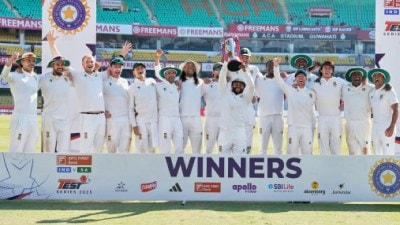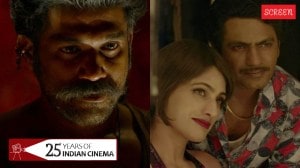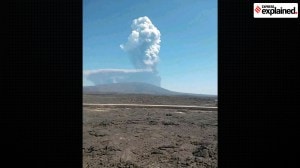Click here to follow Screen Digital on YouTube and stay updated with the latest from the world of cinema.
25 years of Joint Security Area: The Korean ‘Veer-Zaara’ coded movie that became its saddest reality
Park Chan Wook’s Joint Security Area, starring the likes of Lee Byung-hun and Song Kang-ho, broke taboos by humanising North Korean soldiers.
 25 years of Park Chan-wook’s Joint Security Area
25 years of Park Chan-wook’s Joint Security AreaJoint Security Area: The Korean Demilitarised Zone, 160 miles long and about 2.5 miles wide, has remained a hot topic not only in parliaments but also in the film industry. One early film took on the subject and pulled off what diplomacy couldn’t. Before Park Chan Wook became known for Oldboy, this movie was his breakthrough, shifting public perception on both sides of the border. But the years since have only brought more roadblocks, and today, its themes linger as a sad reminder for a younger generation left to carry the weight.
As both India and South Korea celebrate their independence and liberation day on August 15, the only sad truth is how decades-long animosity between neighbors always comes at a personal cost. Some 20 years ago, India’s attempt to ease border tension with Veer-Zaara, starring SRK and Preity Zinta, was another reminder of this reality, of the longing for peace that silently exists beneath the noise of political tension.
25 years of Joint Security Area
Park Chan Wook’s Joint Security Area (2000) broke long-standing taboos by showing North Korean soldiers not as faceless enemies, but as men with the same culture and humour as those across the border. They laughed, cracked jokes, shared chocolate, and even sang along to the same pop tunes, though their lives were far more guarded, buried in fear. Park caught a break with timing as the film landed during the “Sunshine Policy” years, when North and South Korea were cautiously warming ties. That same year saw their first-ever leaders’ summit since the peninsula was split. The two nations had fought the Korean War from 1950 to 1953, ending without a peace treaty and an armistice that still holds today.
Also read: North Korea warns of reprisal against South Korea-US drills despite signs of tensions easing
For Park, who invested a long time into detailing and creating a realistic set of the border, it was a risky move. Under South Korea’s strict National Security Act, “praising the enemy” could mean prison. Park and his team were ready to face backlash and even prepared themselves for jail time, but the summit that occurred just a few months before the release, when South Korean President Kim Dae Jung met Kim Jong Il, turned the table for JSA. The movie swept awards, became South Korea’s biggest hit at the time, and even made its way to North Korean leader Kim Jong Il via DVD.
But today, the reality is different. Pyongyang has renounced reunification, cross-border family reunion venues have been taken down, and troops have rearmed on both sides of the Demilitarised Zone. “It is a sad reality that this movie’s themes still resonate with the younger generation,” Park said earlier this year in Seoul during a press conference. “I hope that by the 50th anniversary, we will be able to discuss it as just a story from the past.”
Joint Security Area was hailed as a masterpiece, with all its stars going on to achieve success, including Squid Game actor Lee Byung-hun and Song Kang-ho, who later starred in the Oscar-winning Parasite. But when Park took on the project, after two flops, he decided to gamble on one of the most sensitive topics. Deep down, he feared that portraying inter-Korean bonding could cross the line into what South Korea’s law calls “glorification” of the communist North.
The movie tells the story of a sad but unlikely friendship. Two North Korean soldiers help a South Korean soldier who accidentally steps on a landmine. The most famous yet gruesome spot in the DMZ is the Joint Security Area (JSA) at Panmunjom. It’s the only place where North and South Korean soldiers stand just a few meters apart, facing each other. Before the Joint Security Area, showing North Korean soldiers as normal people and not some monsters in South Korean movies was almost unheard of. The film changed the perspective, and even though the situation has worsened since, many K-dramas, including Hyun Bin and Son Ye Jin’s Crash Landing on You, and movies have tried to ease the tension with balanced storytelling, extending an olive branch to the public, if not to the government. In 2019, Kim Jong Il even shook hands with U.S. President Donald Trump across the border. But in 2017, North Korean soldiers shot at one of their own who was trying to defect, and in 2023, both sides brought weapons back into the area after a peace agreement fell apart.
In Veer Zaara, one of Bollywood’s biggest hits, the love story between Veer Pratap Singh, an Indian Air Force pilot, and Zaara Hayaat Khan, a Pakistani woman, shifted public sentiment too. The film dealt with the personal cost of conflict, Veer’s 22 years in a Pakistani prison and Zaara’s lifetime of waiting, only to remind us that love can rise above the India-Pakistan divide. It dared to present a story of mutual respect and affection between Indians and Pakistanis. Yet, years later, the two countries still can’t see each other beyond the lines drawn by conflict.
- 01
- 02
- 03
- 04
- 05


































